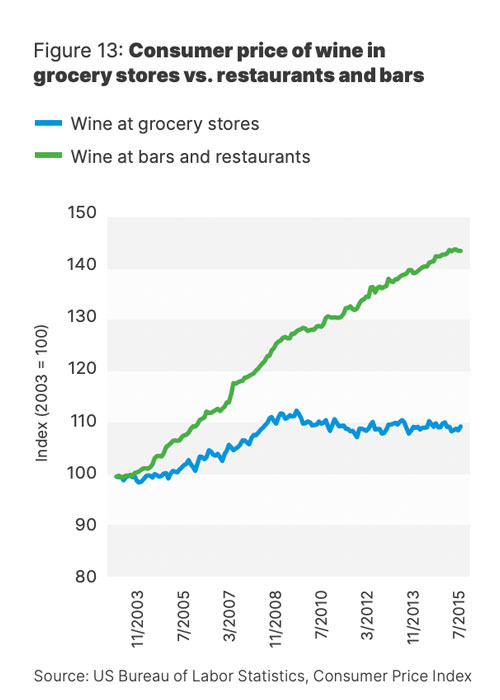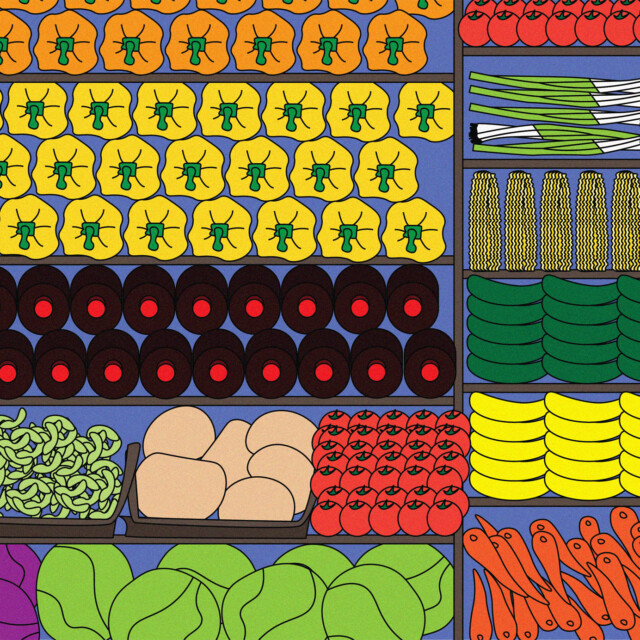Some wines don’t look as good under fluorescent lights, but luxury wines are making strides in improving your grocery store’s wine aisle.
While in previous decades Americans could expect to only find swill while looking to imbibe at their local convenience store, that is no longer the reality. Luxury wine sales in the United States were up 21 percent in 2021, according to Silicon Valley Bank’s State of the Wine Industry (SVB). During that period, consumers were beginning to shift away from brick-and-mortar retail locations, with more restaurants and tasting rooms reopening over the course of the year. Yet, according to the SVB, the prices of wine in grocery stores stabilized in 2009 while at the same time accelerating in restaurants, creating an ever-widening gap for mark-ups on wine lists.
VinePair spoke to officials at iconic brands Möet Hennessy and Simi Winery — both of which can be found on supermarket shelves — about how they’ve moved away from Two-Buck Chuck stereotypes and are finding success in retail.
According to Anne-Sophie Stock, vice president of Möet Hennessy, luxury brands can actually benefit from being in spaces like grocery stores and should disregard any negative stereotypes. She says retail locations help consumers realize that these goods can be enjoyed beyond momentous occasions. “Celebratory moments come in all shapes and sizes: a birthday, promotion, proposal, or even toasting to smaller milestones that our drinkers have worked tirelessly to achieve,” says Stock. “We want to ensure that our bottles are easily findable in everyday life, and grocery stores are certainly top of that list.”

Stock believes that one of the reasons that LVMH’s wines are so successful in this arena is because of how recognizable its brands already are — Veuve Cliquot’s iconic marigold label can easily be spotted down an aisle. Being in grocery stores, these brands are available to consumers at any point of their day-to-day lives and can “meet them where they shop.”
Supermarket wines have long suffered from the negative connotation associated with convenience as the lion’s share of wine sales are last-minute impulse buys, according to Wine Business. In 33 states and the District of Columbia, wine can be sold at “food stores,” and in most of said states, retailers are allowed to carry multiple wine licenses.
Small-production winemakers typically cannot enter or compete in supermarkets because of their limited stock, paving the way for cheaper, larger production brands to take over the majority of wine aisles. “With grocery stores, they choose to work with a smaller selection of distributors, so they tend to work with distributors that have larger portfolios that are more stable and consistent,” says Jake Lewis, buyer at Convive Wines and Spirits in NYC. “In addition, at grocery stores, they are restrained by planograms that were finalized in collaboration with brands months in advance, deciding which bottles will be featured and where.”
While Möet Hennessy’s products are considered top-tier and carefully crafted, Stock says that being in more casual retail spaces also helps ensure a trustworthy and reliable relationship with consumers. “Each bottle of our Champagne and sparkling wine that consumers buy, open, and enjoy has been crafted with precision and care,” says Stock. “These aren’t products that can be created overnight. That said, we are also very much in the mindset that our products should be accessible and easily enjoyed.”
Accessibility is also the name of the game for Simi Winery, and the supermarket is one of the key channels the brand recognizes for consumers to first approach and discover the brand, according to Billy Lagor, senior vice president of brand management. Simi, one of the oldest continuously operating wineries in California, takes pride in its widespread availability and doesn’t see how being in supermarkets could create any negative stereotypes for the brand. “Getting our wines into the hands of loyal fans and new customers alike at grocery stores and other easily accessible locations helps us share the taste that sets us apart with a wider audience,” says Lagor. “The exposure our wines receive at grocery stores positively affects Simi’s image, bringing new people to the brand and inviting them to learn more about our wines, the winery, and our visionary leader Isabelle Simi.”
Lagor claims that many of the successes of Simi translate well to managing the reception and image of other brands by ensuring that high-quality wines can be found anywhere and at any price point, which is further bolstered by providing a sense of history in each bottle. “We are thrilled to continue the legacy of female winemaking with our current director of winemaking, Lisa Evich, who leads an all-female winemaking team,” says Lagor. “Over the years, we have seen consumers increasingly understand that high-quality wine can be easily accessible, approachable, and actually quite affordable for everyday drinking.”
